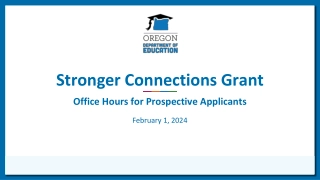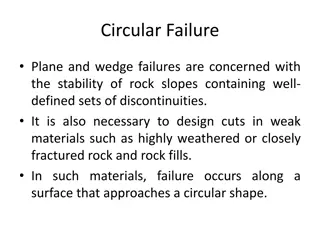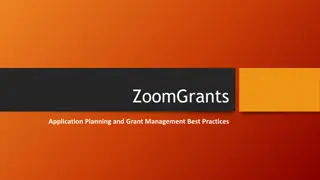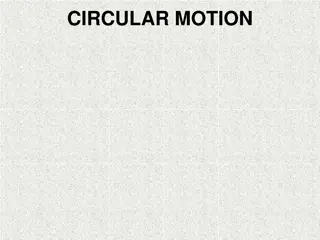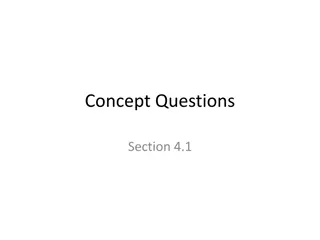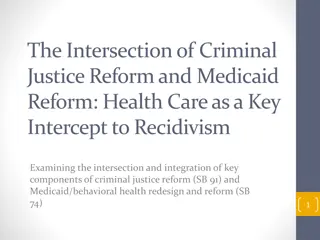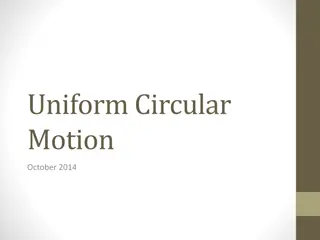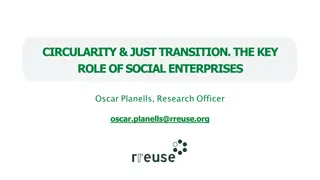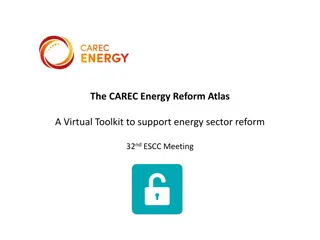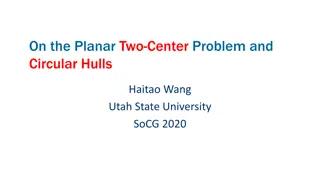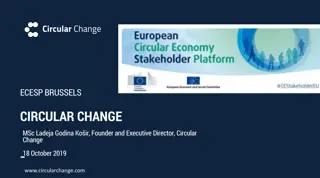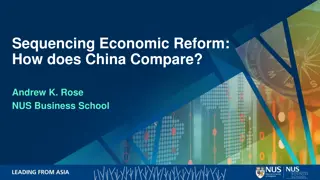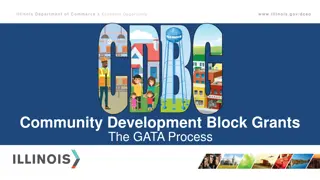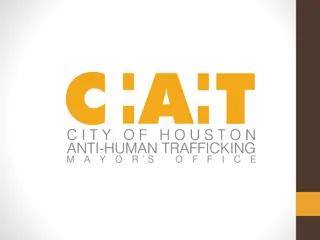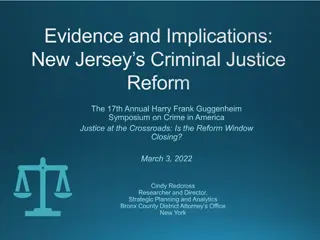Grant Reform: The Super Circular Explained
The Uniform Guidance (UG) is a reform that consolidates circulars for the costing, administration, and audit of Federal awards. Issued in 2013, it aims to streamline guidance, reduce administrative burdens, and enhance oversight to prevent waste and fraud. Learn about its high-level goals and the codification of eight OMB circulars in this comprehensive overview.
Download Presentation

Please find below an Image/Link to download the presentation.
The content on the website is provided AS IS for your information and personal use only. It may not be sold, licensed, or shared on other websites without obtaining consent from the author.If you encounter any issues during the download, it is possible that the publisher has removed the file from their server.
You are allowed to download the files provided on this website for personal or commercial use, subject to the condition that they are used lawfully. All files are the property of their respective owners.
The content on the website is provided AS IS for your information and personal use only. It may not be sold, licensed, or shared on other websites without obtaining consent from the author.
E N D
Presentation Transcript
Grant Explained - Everything You Need To Know Reform: The Super Circular 1 AN BAL JOVER PAG S, CPA, CGMA ANTHONY D. CRUZ ALDECOA, CPA
What is the Uniform Guidance (UG!)? 3 OMB s consolidation of circulars for costing, administration and audit of Federal awards 2 CFR 200 replaces 8 circulars and applies to universities, state and local governments, nonprofits, native tribes Issued on December 26, 2013 Effective largely on December 26, 2014 Biggest change in Federal regulations in 50 years Some good news, some new administrative burdens Each Federal agency will implement a slightly different version of the UG UG is still being interpreted and clarified
What are the high level goals of the Omni-Circular? 4 Streamline guidance on federal awards Reduce administrative burden for the government Strengthen federal oversight of funding, to reduce potential for waste, fraud and abuse. Set standard requirements for financial award management uniformly across all federal agencies Locate all OMB Circulars into Title 2 of the CFR (i.e. consolidation of 8 OMB Circulars into Title 2 of the CFR) Increase efficiencies and effectiveness of Federal Award making (i.e.- best use of funds)
CODIFICATION OF EIGHT OMB CIRCULARS 5
Organization of the Omni-Circular, 2 CFR Part 200 Uniform Guidance 6 Subpart A Acronyms & Definitions Subpart B General Provisions (Section 200.1xx) Subpart C Pre-Award Requirements (Section 200.2xx) Subpart D Post Award Requirement (Section 200.3xx) Subpart E Cost Principles (Section 200.4xx) Subpart F Audit Requirements (Section 200.5xx) TERMS TO REMEMBER: Must means Required Should means not required but is best practice Pass-Through Entity is Prime Recipient
Organization of the Omni-Circular, 2 CFR Part 200 Uniform Guidance, cont d 7 Appendix I Full text of the Funding Opportunity Notice Appendix II Contract provisions for non-fed entities Appendix III F&A Identification and assignment for Higher- Ed (Indirect Cost Identification & Assignment, Rate Determinations) Appendix IX- Hospital Cost Principles Appendix XI- Compliance Supplement In total 11 Appendices- I through XI
Uniform Grant Guidance Effective Dates 8 Federal agencies (FA) must implement policies and procedures by promulgating regulations to be effective December 26, 2014. Non-federal entities will need to implement the new administrative requirements and cost principles for all new Federal awards made after December 26, 2014 and funding increments after that date where Federal agencies change award terms and conditions FAQ .110-6 - Effective Dates and Grace Period for Procurement. FAQ .110-7 Effective Dates and Incremental Funding. NFE may implement entity-wide system changes to comply with the UG without penalty. Audit requirements effective for fiscal years beginning on or after December 26, 2014: No early implementation of audit provisions.
A Closer Look at Effective Dates 9 All 2014 year ends: No impact from the UG for NFE and auditors. Quarters ending March 31; June 30; and Sept 30, 2015: NFE use new Administrative Requirements and Cost Principles for all new awards and funding increments with changed terms and conditions. OMB Circular A-133 audit requirements remain. NFE likely have awards subject to the old requirements and awards subject to the new requirements. December 31, 2015, year-ends and beyond: New Single Audit requirements apply.
Conflict of Interest 10 200.112 (NEW) Requires Federal awarding agencies to establish a conflict of interest policy for Federal awards. The non-Federal entity must disclose in writing any potential conflict of interest to the Federal awarding agency or pass-through entity in accordance with applicable Federal awarding agency policy. This refers to conflicts that might arise around how a non-Federal entity expends funds under a Federal award. These types of decisions include, for example, selection of a subrecipient or procurements as described in section 200.318. Requires a disclosure to the awarding agency of potential conflicts of interest in accordance with that agency s policy Agencies implementation plans should be reviewed for additional guidance or requirements
Key Sections-Subpart C 200.201 Use of Grants (including Fixed Amount Awards) Coop- Agreements and Contracts: (NEW) 11 Federal Agency must determine appropriate award instrument Incorporates new guidance for fixed amount awards Payments based on specific requirements; Accountability based on performance & results; Award amount negotiated using cost principles as a guide; Significant changes require prior approval. New guidance appears to imply that accountability at the end of a fixed amount award, may require that the amount of the award be adjusted downward accordingly. Conversation point: This could have impacts on when a program is run for less than was budgeted. Historically, the grant recipient could retain the residual. Perhaps no longer the case?
Key Sections Subpart C 200.203 Notice of Funding Opportunities (NEW) 12 Specifies a set of 6 mandatory data elements (standardization) Identifies the full text that must be included in funding opps, (Appendix I of Part 200) Establishes minimum timeframe (60 days) that federal agencies must generally make funding opportunities available to applicants Agencies must generally post opportunities at least 60 calendar days prior to due date, but no opportunities should be available for less than 30 calendar days. Talking point: This is a good move toward standardizing funding opps, and while 60 days lead time is not as good as 90, it is still an improvement
Key Sections Subpart C 200.204 Federal Agency Review of Merit (NEW) 13 This is new requirement, and helps the small or middle size applicants understand the playingfield Federal agencies must design and execute merit review processes for applications The merit review process must be described in the in the funding opp (i.e. - transparency to the applicant) Talking point: This is a good addition that allows applicants to fully understand the merit review criteria, and review process.
Key Sections Subpart C 200.205 Federal Agency Review of Risk 14 Federal agencies must have a framework for evaluating risks by applicants, prior to making awards. Possible risk items considered by the agencies Financial stability History of performance Audit reports Applicants ability to implement effective systems Conversation point: Importance of delivery of timely progress reports, having effective management systems implemented, etc. is amplified.
Risk Assessment of Applicant- Subpart C 15 Agency must perform risk assessment of awardees: Debarment List Do Not Pay List Federal Awardee Performance and Integrity Information System (FAPIIS) past performance Dun and Bradstreet reports Prior audits Death Master File of SSA Debt Check Database of US Treasury Credit Alert System HUD Incarcerated individuals
Key Sections Subpart C 200.210 Information Contained in a Federal Award 16 Provides a set of 15 standard data elements that must be provided in all Federal awards, and also flowed down in Subawards Requires agencies to incorporate general terms and conditions Conversation point: Clarification is being sought by the grants community regarding if the second point above refers to the Research and Related Terms
PERFORMANCE REPORTING 17 200.301 Continued pressure from agencies to relate research progress to financial information and other data (e.g., number of students, publications, patents) The Federal awarding agency must require the recipient to use OMB-approved governmentwide standard information collections when providing financial and performance information. The Federal awarding agency must require the recipient to relate financial data to performance accomplishments of the Federal award. Also, in accordance with above mentioned governmentwide standard information collections, and when applicable, recipients must also provide cost information to demonstrate cost effective practices (e.g., through unit cost data). Guidance provides for research sponsors to use standard Research Performance Progress Report (RPPR) format depends on agency implementation (NSF is on board!)
Key Sections Subpart D 200.303 Internal Controls 18 Recipients required to have internal controls in place that comply with federal statutes and regulations Institutions and their auditors will need to review COFAR offers the following source documents to be used as best practice, but are not prescriptively required Standards for Internal Control in the Federal Government (Green Book) issued by the Comptroller General. (Should Follow) Internal Control Framework issued by the Committee on Sponsoring Organizations (COSO) Appendix XI, Compliance Supplement Part 6 Internal Control (which currently follows COSO but will consider both the Green Book and COSO in the 2015 update (200.514(c)(1))
Key Sections Subpart D 200.306 Cost Sharing or Matching Clarification is made that voluntary committed cost sharing is not expected under federal research proposal Voluntary Committed Cost Share cannot be used as a factor during the merit review of the proposal Cost Sharing may only be offered/considered when it s required by regulation and transparently displayed in the funding opportunity Conversation point: This is a great clarification that is similar to NSF s policy on cost share. 19
Key Sections Subpart D 200.307 20 PROGRAM INCOME (PI) 200.307 Income from license fees and royalties on research funded by a Federal award should be excluded from the definition of program income. US law or statute takes precedent over the Uniform Guidance. The guidance in section 200.400(g) states that the non-Federal entity may not earn or keep any profit resulting from Federal financial assistance, unless expressly authorized by the terms and conditions of the Federal award. If the Federal agency does not specify in its regulations or the terms and conditions of the Federal award how program income is to be used, the Addition method must apply. When the Federal awarding agency authorizes the Addition method or Cost sharing or matching, program income in excess of the amounts specified must also be deducted from expenditures. The default to the Addition method for IHEs and nonprofit research institutions standardizes this practice. Under A-110, standard use of the Addition method for IHEs and nonprofit research institutions is not specified as the default.
Key Sections Subpart D 200.308 21 200.308 Revision of budget For non-construction Federal awards, recipients must request prior approvals from Federal awarding agencies for one or more of the following program or budget-related reasons: The disengagement from the project for more than three months, or a 25 percent reduction in time devoted to the project, by the approved project director or principal investigator New language added to reflect that project directors can be away from campus and remain engaged in the project at the proposed and awarded levels. Disengagement from the project for more than three months, rather than absence from the project (A-21).
Key Sections Subpart D 200.313 Equipment 22 Property records must contain percentage of federal participation in the project costs for the federal award that the equipment was purchased. Very Confuse Property records must contain the use of the equipment 200.313 (d) (1) Subpart also includes disposition rules Talking point: The guidance isn t entirely clear, and adds a layer of record keeping elements that for example may need to modify in its tracking systems for non- Federal entities (NFE).
COMPETITION 25 200.319 The non-Federal entity must conduct procurements in a manner that prohibits the use of statutorily or administratively imposed state or local geographical preferences in the evaluation of bids or proposals, except in those cases where applicable Federal statutes expressly mandate or preference. encourage geographic This could create conflict for public universities required to follow State Statute
Methods of Procurement 26 200.320 A prescriptive list of 5 procurement methods are provided New category of micro-purchase which appears to allow purchases of up to $3,000 without competition Small purchases over $3,000 would rate quotations at least two Concern: This could have implications on procurement card programs and bid thresholds. The current threshold on P-Cards is $5,000 COFAR issued FAQ granting a 1-year grace period to review additional options for implementation.
Subrecipient Monitoring 27 200.330 Vendor vs. subrecipient classification Clarification that pass-through entity must make determination classification Each agency may supply and require pass-through entities to comply with additional guidance to support their classifications Probable increase in subrecipient 200.331 monitoring burdens Explicit list of mandatory and optional factors to be included in subrecipient monitoring New obligation to review financial and performance reports PI s will be required to certify that they received and reviewed performance reports from the subrecipients.
Key Sections Subpart D 200.331 Subrecipient Monitoring (NEW) 28 F&A guidance is improved; use the subrecipient s negotiated rates, or subrecipients without a negotiated rate can get an automatic 10% MTDC rate. (200.414) Agency must grant prior approval for issuing fixed price subawards New maximum limit for fixed price subawards $150K Potentially more risk assessment burden for OSP as audit threshold increases to $750K, time will tell
Key Sections- Subpart D 29 When a non-Federal entity uses the cash basis of accounting, the cost of leave is recognized in the period that the leave is taken and paid for. Payments for unused leave when an employee retires or terminates employment are allowable as indirect costs in the year of payment. OMB issued a clarification in the Aug. 29 FAQ s Will soon issue a clarification of the clarification
Closeout 200.343 30 No stated change for recipient, but All reports due no later than 90 calendar days after the end date of the period of performance New emphasis on progress reports New circumstances Pressure on agencies (OMB 7/2012 Controller Alert) Changes in NIH and NSF financial reporting award by award Enforcement through 90 days for cash draw Frustration over progress reports Closeout is the focus of a new FDP/COGR (Federal Demonstration Partnership/Council on Governmental Relations) working group
Key Sections Subpart E 200.407 Prior Written Approval 31 New section clarifies that in order to avoid disallowed costs, recipients can seek prior approval of the agency One stop section that provides a comprehensive list of circumstances for which we can seek prior approvals This section is key for the incurrence of unusual costs or costs that fall in a grey area
Key Sections Subpart E 200.413 Administrative Costs as Direct Costs 32 Administrative and Clerical Salaries are still normally treated as F&A costs. Direct charging of these costs may only be appropriate if all 4 of the following conditions are met: Admin or Clerical services are integral to the project or activity Individuals involved can be specifically identified with the project or activity Such costs are explicitly included in the budget (at proposal) or have the prior written approval of the Agency The costs are not also recovered as indirect costs This section now removes the majorproject requirement, and recognizes administrative workload, though we note that #4 above is somewhat confusing criteria and await further clarification from the agency implementations; this section may require further analysis 1. 2. 3. 4.
Key Sections Subpart E 200.414 Indirect (F&A) Costs 33 Federal acceptance of approved IDC rates Federal awarding agency must accept approved negotiated IDC rates, unless otherwise required by federal statute, regulation, or when approved by agency head or delegate. New de minimis rate of 10% for entities that do not have negotiated rates Any non-federal entity that has a federally negotiated rate may apply for a one time extension, for a period up to 4 years. Conversation Point: These updates are generally helpful to grant recipients, particularly the de minimis rate when working with Subrecipients that don t have negotiated rates
Key Sections Subpart E 200.415 Certifications 34 Annual and final fiscal reports or vouchers requesting payment must include a certification signed by an official who can legally bind More strongly worded certification language that introduces potential penalties under the false claims act, for fraudulent information for omission of material facts
Required Certifications 35 200.415: By signing this report, I certify to the best of my knowledge and belief that the report is true, complete, and accurate, and the expenditures, disbursements and cash receipts are for the purposes and objectives set forth in the terms and conditions of the Federal award. I am aware that any false, fictitious, or fraudulent information, or the omission of any material fact, may subject me to criminal, civil or administrative penalties for fraud, false statements, false claims or otherwise. (U.S. Code Title 18, Section 1001 and Title 31, Sections 3729 3730 and 3801 3812). Extremely strong language may find opposition signed by an official who is authorized to legally bind the non-Federal entity May require signature authority/delegation at institution Important to ensure all costs are allowable and allocable to the project via periodic reviews of individual transactions.
Key Sections Subpart E 200.430 Compensation Personal Services 36 New Language Strengthening of Internal Controls Examples that used to be provided have now been removed. (A-21 Removed) These prior examples had been interpreted by auditors to be the prescription The term EffortReports is no longer explicitly mentioned Conversation point: While the prescriptive language has changed, and examples removed, there is still a strong focus on accountability and internal controls regarding compensation on federal awards.
Key Sections Subpart E 200.431 Fringe Benefits 37 When a non-Federal entity uses the cash basis of accounting the cost of leave is recognized in the period that the leave is taken and paid for. Payments for unused leave when an employee retires or terminates employment are allowable as indirect costs in the year of payment.
Key Sections Subpart E 200.431 Fringe Benefits 38 Family related leave is allowable (NEW) Change in accounting for unused leave? Impacts on Fringe rates? Severance Pay is clarified and introduces categorizations of normal severance pay and; mass or excessive severance pay. (Abnormal) Severance pay by means of an accrual will not achieve equity to both parties Talking point: Multiple internal stakeholders will be engaged to review this section of the Uniform Guidance and evaluate current and future processes.
Compensation-Personal Services 39 200.430 More Flexibility Eliminated Examples of acceptable Methods for Payroll Distribution Added concept of IBS (Institution Base Salary) (ii) The non-Federal entity establishes a consistent written definition of work covered by IBS which is specific enough to determine conclusively when work beyond that level has occurred Allowable activities: Added language to allow for developing and maintaining protocols . managing and securing project-specific data, coordinating research subjects Also added (2) For records which meet the standards not be required to provide additional support or documentation for the work performed
200.430 (i) Standards for Documentation of Personnel Expenses 40 Include (8) Standards for Documenting Records Substitute Systems are allowed for measures of work performed (i.e. Temporary Assistance for Needy Families (TANF)).
Key Sections Subpart E 200.432 Conference Costs 41 Requires conference hosts to exercise discretion and judgment to ensure that conference costs are appropriate, necessary and managed in a way that minimizes cost to the federal award (remember the notion of waste and abuse) As needed, the costs of identifying, but not providing, locally available dependent- care resources are allowable Conversation point: The second point above is also reflected in Travel 200.474 and Fringe 200.431, as an encouragement of family-friendly practices. University policies will be evaluated for current and future practices, as the Uniform Guidance requires consistent treatment between federally funded programs and non-federal programs.
Key Sections Subpart E 200.453 Materials and Supplies 42 Material and supplies section now specifically includes computingdevices as an allowable direct cost. In the specific case of computing devices, charging as direct costs is allowable for devices that are essential and allocable, but not solely dedicated, to the performance of a federal award. Talking point: This clarification is extremely helpful in acknowledging that computing devices are an allowable supply cost. Note the but not solely dedicated phrase as we discuss reasonable allocation strategies moving forward.
Key 200.456 Participant Support Costs Sections Subpart E The treatment of participant support costs is now defined uniformly for all federal agencies and not just NSF Handled consistently with NSF practice, removed from the MTDC base and not subject to F&A Rebudgeting of participant support costs will require prior approval 43
Key Sections Subpart E 200.461 Publication and Printing Costs 44 A key grey area has been resolved; charges that are necessary to publish research results and that occur after the period has ended are allowable. The non-federal entity may charge the federal award before closeout for the costs of publications or sharing of research results if the costs are not incurred during the period of performance of the federal award. Conversation point: This is helpful clarification that enables faculty to publish research results after the award period of performance, but prior to grant closeout.
Key Sections Subpart E 200.463 Recruitment Costs Clarification is made that now allows short term travel visas (but not longer term immigration visas) Conversation point: This clarification is consistent with NSF s recent policy update on allowability of short term travel visas. 45
Key Sections Subpart E 200.474 Travel Costs 46 Temporary dependent care costs above and beyond regular dependent care that directly results from travel to conferences, is allowable provided: Cost is direct result of individual s travel for the federal award, Cost is consistent with non-federal entity s travel policy for all travel (not just sponsored), and Cost is only temporary during the travel period Talking Point: University travel policies will be evaluated for current and future practices, as the Uniform Guidance requires consistent treatment between federally funded programs and non-federal programs.
Objectives of Changes to the Single Audit Process 47 Concentrate audit resources, oversight and resolution on higher $ and higher risk awards Strengthen audit procurement procedures Increase $ threshold triggering a Single Audit Reduce compliance issues to be tested Clarify and streamline programs to be tested Improve reporting on findings Improve coordination on audit finding resolution and corrective actions
Sec. 200.5XX, Audit Requirements Basic Structure of Single Audit Process Unchanged 48 Audit threshold (200.501). Subrecipient vs. Contractor (200.501(f) & 200.330). Biennial (200.504) & Program-specific (200.507) audits. Non-Federal entity selects auditor (200.509). Auditee prepares financial statements & SEFA(200.510). Audit follow-up & corrective action(200.511 & 200.521). 9 month due date (set in law) (200.512(a)). Reporting to Federal Audit Clearinghouse (200.512). Major programs determined based on risk (200.518). Compliance Supplement overall format (Appendix XI).
Major Program Determination Type A/B Threshold Step 1 49 Programs are grouped based on dollars. Type A programs are those above the threshold. Type B are those below the threshold. Type A/B threshold is a sliding scale with minimum. Minimum increases from $300,000 to $750,000. Threshold presented in table to be more easily understood. Audit threshold and Type A/B minimum threshold will be the same at $750,000.
Type A/B Threshold- Table (200.518 (b)(1)) 50 M means Million Dollars and B means Billion Dollars. LT means Less Than. EQ means Equal To.
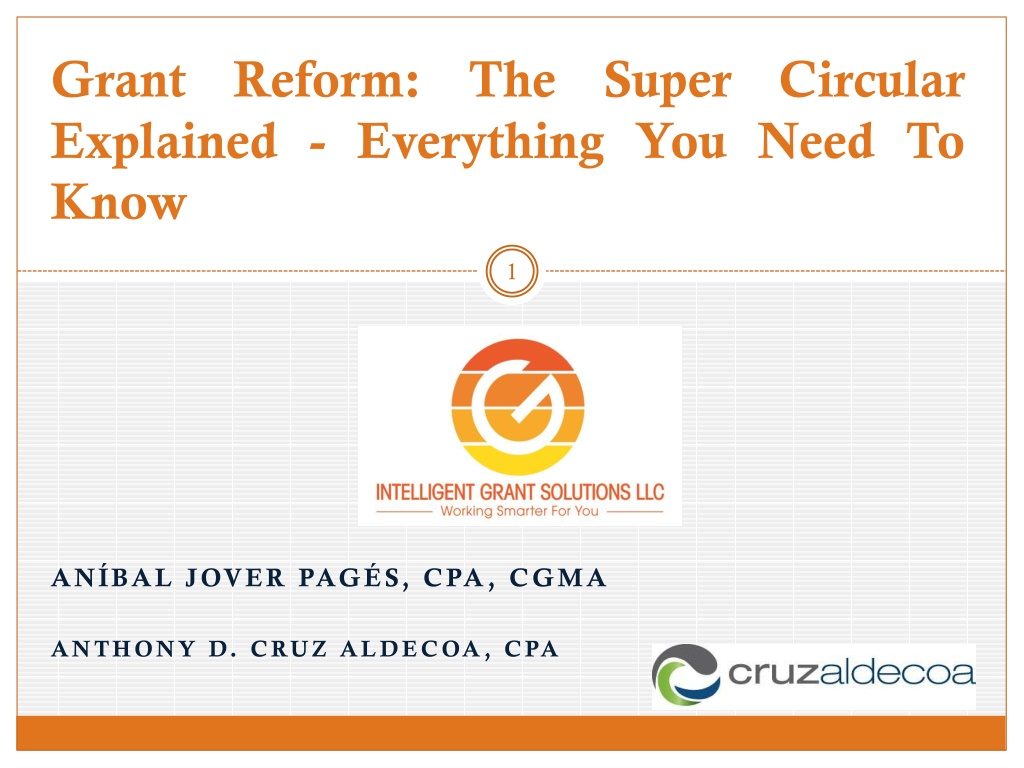
 undefined
undefined











